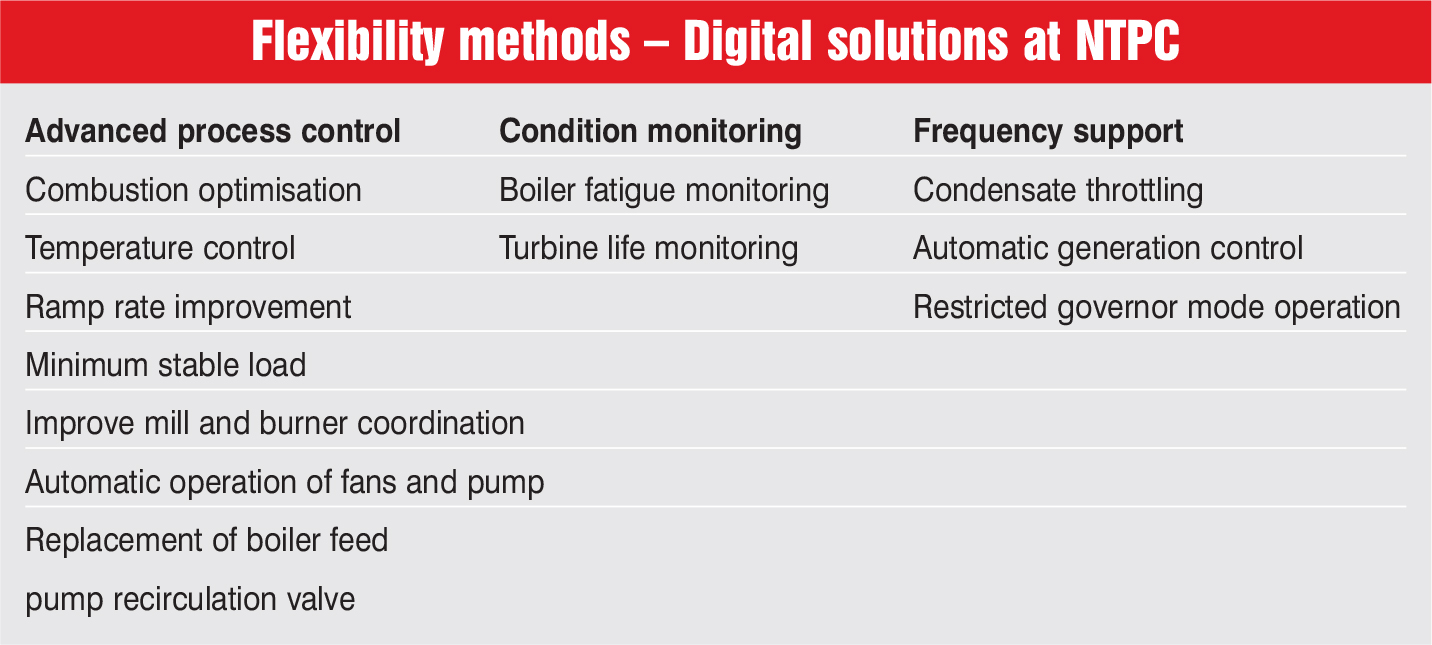
With the growing influx of renewables, there is a greater need for flexibilisation of conventional coal-based power plants. The total renewable energy capacity in India is over 149 GW (including large hydro) and its share in the total power generation is set to increase exponentially in the coming years given the country’s recently announced target of 500 GW of renewables by 2030. The power sector is witnessing a shift from pure commodity market to a more solutions-oriented market and round-the-clock supply is an emerging requirement. It has also become essential to add hydro generation and low-cost renewables to reduce the average cost of power. The variability, uncertainty, and the geographically confined nature of renewable energy is creating a challenge for grid operators and generators. A number of factors are affecting the grid system. These are difficulties in load frequency control, the requirement of an enhanced transmission network, need for ancillary services and a resulting increased system operation cost. Besides, the variability of renewable power leads to lower plant load factor (PLF) due to non-availability of schedule, high ramping requirement, two shifting and cycling of plants, increased forced outage, and operations and maintenance (O&M) cost, lifetime reduction of equipment, poor heat rate, high auxiliary power and increased capex on generating stations. The need of the hour is to encourage the participation of players with a flexible generation mix.
Digital tools for flexibilisation
Digitalisation can be effectively used for flexible operations of conventional power plants. Some digital tools that may be applied alongside the existing control system include advanced tuning of existing control loops, advanced process control (APC) software, advanced asset monitoring system, advanced pattern recognition software, advanced fatigue monitoring system, and advanced combustion control techniques.
NTPC Limited has adopted certain digital tools to enable flexibilisation. These include APC software solutions for faster load ramp up and ramp-down, superheater/re-heater temperature excursion reduction (reduction in standard deviation from set point), stability of control loops such as drum level and furnace pressure at lower load, mill scheduler, boiler feed pump, recirculation control valve for feed water control at low load, 40 per cent minimum load with coordinated master control, that is, with automatic parameter control. APC solutions can also aid in combustion optimisation, temperature control, ramp rate improvement, minimum stable load, improving mill and burner coordination, and automatic operation of fans and pumps.
The utility has deployed condition monitoring for boiler fatigue monitoring and turbine life monitoring. In boilers, the monitoring of the condition of thick wall pressure parts is important. The software available for monitoring increased stresses due to cyclic operation are being used by NTPC. In turbines, part-load operations may lead to steam temperature changes, especially hot reheat temperature which develops stress in the equipment. Therefore, solutions for calculating equivalent operating hours are being considered for flexible operation.
Solutions for frequency support include condensate throttling, automatic generation control and restricted governor mode operation.
 Increased stress on equipment makes it prone to frequent failures. Hence, measures of advanced asset management are undertaken. Some solutions include optimisation of scheduled maintenance of equipment by doing reliability centred maintenance, analysing the pattern of failure of equipment in earlier incidents, optimisation of O&M cost and improving availability of equipment.
Increased stress on equipment makes it prone to frequent failures. Hence, measures of advanced asset management are undertaken. Some solutions include optimisation of scheduled maintenance of equipment by doing reliability centred maintenance, analysing the pattern of failure of equipment in earlier incidents, optimisation of O&M cost and improving availability of equipment.
Cost of flexibilisation
Flexible operations involve a one-time cost, that is, capital expenditure or capex. There is also an increase in operational expenditure due to the increase in start-up costs, O&M costs, load following and ramping costs, fuel and other input costs.

- Start-up cost: Cycling start-up costs have a very large spread or variation and are unique to every start-up type, that is, cold, warm and hot).
- O&M cost: Increased maintenance is required along with more frequent component replacements due to increased life consumption and damage due to cycling.
- Load following and ramping costs: Most units were designed for baseload operation and can undergo significant damage due to change in operations.
- Start-up fuel input and others: Start-up cost due to inputs such as water, chemicals, additives and auxiliary power.
- Degradation of heat rate due to cycling also impacts costs.
- Increase in fixed cost per unit due to lower PLFs.
Overall, the total cost of cycling is the sum of the increased cost of repair and maintenance, replacement power cost due to forced outages (through real-time market), long-term heat rate impacts (due to equipment deterioration), operational heat rate impacts (due to part-load compensation), cost of start-up auxiliary power and chemicals, fuel as well as manpower and capital cost impacts due to unit life shortening and capital equipment replacement.

Conclusion
The flexibilisation of TPPs involves several challenges such as a reduction in the efficiency of plants and increased risk of failures. It also increases the cost of operations. However, monitoring, analytics and automation can help tackle these challenges to an extent. Automation and APC solutions are cost-effective and proven measures to help flexible operation. These solutions are also effective in part-load operations of units, efficiency and reliability improvement. Besides, with flexibilisation measures, advanced asset management becomes necessary to safeguard the heath of equipment.
It has been seen that a subcritical TPP fleet is more suitable for flexible operation. Smaller-sized TPPs could be used for high flexibilisation since flexible operation costs decrease with the unit size. Operating expenses can be based on benchmarked costs to compensate for the increased costs, and the capex can be reimbursed on an actual basis after an examination. There is a need for policy and regulatory intervention, including a revised tariff structure and a grid code, to push gencos to undertake further projects.
With inputs from a presentation by S.K. Dutta, general manager and HOD C&I, NTPC Limited, at a recent Power Line conference.
